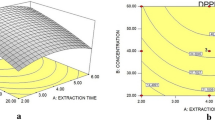Abstract
In the present study, the process of separation and purification of isohamnetin from marc of sea buckthorn was obtained. The antioxidant properties of the pure isolated isorhamnetin were evaluated by the scavenging of the diphenylpicrylhydrazyl radical (DPPH), iron (III) to iron (II)—reducing, and iron-chelating assays. High purity isorhamnetin (92.1%) was obtained and the results of antioxidant assays showed that isorhamnetin performed significantly compared with ascorbic acid and BHT, and the linear correlations were good in these assays. In conclusion, isorhamnetin may have potential as a natural antioxidant to alternate synthetic substances as food additive with its antioxidant activity.





Similar content being viewed by others
References
Sasaki YF, Kawaguchi S, Kamaya A, Ohshita M, Kabasawa K, Iwama K, Taniguchi K, Tsuda S (2002) The comet assay with 8 mouse organs: results with 39 currently used food additives. Mutat Res 519:103–119
Duthie GG (1999) Parsley, polyphenols and nutritional antioxidants. Br J Nutr 81:425–426
Cotelle N (2001) Role of flavonoids in oxidative stress. Curr Top Med Chem 1:569–590. doi:10.2174/1568026013394750
Kim DO, Lee CY (2004) Comprehensive study on vitamin C equivalent antioxidant capacity (VCEAC) of various polyphenolics in scavenging a free radical and its structural relationship. Crit Rev Food Sci Nutr 44:253–273. doi:10.1080/10408690490464960
Dilis V, Vasilopoulou E, Trichopoulou A (2007) The flavone, flavonol and flavan-3-ol content of the Greek traditional diet. Food Chem 105:812–821. doi:10.1016/j.foodchem.2007.01.069
Justesen U, Knuthsen P (2001) Composition of flavonoids in fresh herbs and calculation of flavonoid intake by use of herbs in traditional Danish dishes. Food Chem 73:245–250. doi:10.1016/S0308-8146(01)00114-5
Zheng XY et al (2005) Chinese Pharmacopoeia. Chemical Industry, Beijing, pp 141–142
Chen C, Zhang H, Xiao W, Yong ZP, Bai N (2007) High-performance liquid chromatographic fingerprint analysis for different origins of sea buckthorn berries. J Chromatogr A 1154:250–259. doi:10.1016/j.chroma.2007.03.097
Gordana R, Gutzeit OH, Mqller JL (2005) Structurally related flavonoids with antioxidative properties differentially affect cell cycle progression and apoptosis of human acute leukemia cells. Nutr Res 25:141–153
Dufour C, Loonis M (2007) Flavonoids and their oxidation products protect efficiently albumin-bound linoleic acid in a model of plasma oxidation. Biochim Biophys Acta 1770:958–965
Starzynska AJ, Stodolak BZ, Jamroz M (2008) Antioxidant properties of extracts from fermented and cooked seeds of Polish cultivars of Lathyrus sativus. Food Chem 109:285–292. doi:10.1016/j.foodchem.2007.12.028
Wangensteen H, Samuelsen AB, Malterud KE (2004) Antioxidant activity in extracts from coriander. Food Chem 88:293–297. doi:10.1016/j.foodchem.2004.01.047
Zheng W, Wang S (2001) Antioxidant activity and phenolic composition in selected herbs. J Agric Food Chem 49:5165–5170. doi:10.1021/jf010697n
Hinneburg I, Dorman HJD, Hiltunen R (2006) Antioxidant activities of extracts from selected culinary herbs and spices. Food Chem 97:122–129. doi:10.1016/j.foodchem.2005.03.028
Yang JX, Guo J, Yuan JF (2008) In vitro antioxidant properties of rutin. LWT 41:1060–1066. doi:10.1016/j.lwt.2007.06.010
Carter P (1971) Spectrophotometric determination of serum iron at the submicrogram level with a new reagent (ferrozine). Anal Biochem 40:450–458. doi:10.1016/0003-2697(71)90405-2
Bao MH, Lou YJ (2006) Isorhamnetin prevent endothelial cell injuries from oxidized LDL via activation of p38MAPK. Eur J Pharm 547:22–30. doi:10.1016/j.ejphar.2006.07.021
Yildirim A, Mavi A, Kara AA (2001) Determination of antioxidant and antimicrobial activities of Rumex crispus L. extracts. J Agric Food Chem 49:4083–4089. doi:10.1021/jf0103572
Bush AI (2003) The metallobiology of Alzheimer’s disease. Trends Neurosci 26:207–214. doi:10.1016/S0166-2236(03)00067-5
Author information
Authors and Affiliations
Corresponding author
Rights and permissions
About this article
Cite this article
Pengfei, L., Tiansheng, D., Xianglin, H. et al. Antioxidant Properties of Isolated Isorhamnetin from the Sea Buckthorn Marc. Plant Foods Hum Nutr 64, 141–145 (2009). https://doi.org/10.1007/s11130-009-0116-1
Published:
Issue Date:
DOI: https://doi.org/10.1007/s11130-009-0116-1



